Vol 1 No. 43 TROPIC LIGHTNING NEWS December 16, 1966
Index
New Bde Joins 25th; Div Area Now Largest
United States Army Vietnam has announced the attachment of the 3rd Bde, 4th
Inf Div, to the 25th Division.
The addition of the “Ivy” Div combat troops to what is already the free
world’s largest single combat force in Vietnam gives the 25th the additional
distinction - and responsibility - of covering and wresting from Communist
domination more square miles of Vietnamese soil than any other unit.
The new brigade is currently located at Dan Tieng, 50 miles northwest of
Saigon. This area was the site of the recently concluded Operation “Attleboro,”
the largest operation thus far in the war.
More than 1100 enemy were killed and 3 million pounds of rice captured.
The addition of the brigade-sized combat unit in the Dau Tieng area creates a
triangle of three U.S. Army base camps: the 1st and 2nd brigades of the 25th at
Cu Chi, the 196th Lt Inf Bde at Tay Ninh, and the 3rd Bde, 4th Div at Dau Tieng.
Within and around are areas long noted as Viet Cong, and more recently, North
Vietnamese Army, strongholds. Now, with the mammoth strike force available at a
moment’s notice, no longer will War Zone C, the Boi Loi and Ho Bo Woods, and the
Michelin Plantation be sanctuaries for the enemy.
In addition to the “Tropic Lightning” elements already mentioned, the
division has other record breaking units deployed in Vietnam. The 3rd Bde base
at Pleiku has set the longest consecutive days in combat with Operation Paul
Revere. The previous mark of 165 days was established by the 25th during the
Pacific campaigns of World War II.
Although not under the operational control of Division commander, Maj. Gen.
Fred C. Weyand, the 3rd “ Bronco “ Bde has kept close ties with the parent unit
since leaving Schofield Barracks, Hawaii early this year.
In addition to the brigade-sized forces, one battalion from the Cu Chi base
camp has been deployed to Ben Luc in Long An Province, marking the first time a
U.S. unit has ventured into the region.
 |
APC’S Enroute
Mech Switch Coming at 4/23
The 4th Bn, 23rd Inf., ”Tomahawks” will soon become the first “Tropic
Lightning” unit to be converted to a mechanized outfit in Vietnam.
The changeover from infantry to mechanized infantry will give the battalion
the additional power and speed necessary to carry out its mission against the
Viet Cong in the Cu Chi area.
Armored personnel carriers (APCs) are scheduled to arrive at the Cu Chi base
camp before the Christmas holidays. Preparations for the transition are already
under way.
“The first thing we are doing,” explained Capt. C. E, Demmon, “is tripling
the size of the present motor pool.”
Dump trucks tractors, and scores of men from the 65th Engr Bn are already
clearing, dumping, and rolling hard layers of earth throughout the selected
tract of land.
The next task to be encountered is described as the most difficult of all:
training the drivers.
“Tlrere are two driver training classes scheduled for the men of the
battalion”, explained Capt Demmon. The first is for basic driving which entails
teaching the men how to maneuver the track. And the second is designed to teach
them the various formations and maneuvers used in combat.”
“Mechanized infantry is a new concept of warfare to most of these men,” Capt.
Demnon explained. “They will be able to move faster and farther, but by the
same token they will be restricted in many new ways.”
The 4/23 will be one of the two mechanized infantry battalions assigned to
the 25th Division. The other mechanized outfit, the 1st Bn (Mech), 5th Inf,
“Bobcats,” is assigned to the 2nd Bde.
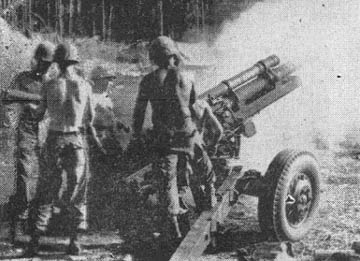 |
SHELL SHOCK - Members of Btry B, 2nd Bn, 9th Arty, fire a 105mm howitzer in support of the 1st Bn, 14th Inf., during a battle in the central highlands. (Photo by Sgt. Michael N. Horowitz) |
Highlands Battle Nets 166 Foe Dead
For the second time in one week and in the same general vicinity, elements of
the lst Bn, 14th Inf, “Golden Dragons” engaged units of the North Vietnamese
Army (NVA) in a duel for control of the central highlands of Vietnam.
On a recent Saturday morning, Companies B and C, plus the Recon Platoon of
the Golden Dragons and an attached Civilian Irregular Defense Group (CIDG)
force, set out on a sweep and destroy mission to blow up an enemy bunker complex
discovered the day before. The infantrymen from the 25th ended up in an
eight-hour fire fight.
Prior to reaching the bunker complex Co B’s right came under enemy small arms
fire and shortly thereafter the CIDG company and the Recon Platoon began
receiving small arms and grenade fire. Within minutes the friendly forces were
engaged with a two-battalion NVA force.
Co B was receiving heavy fire from the front while the Recon Platoon and CIDG
Co were being hit mainly from the west. The forces were pinned down. Co C was
used as a maneuver element since it was the only unit not in contact.
Two platoons of the company began flanking to the west to help relieve the
pressure placed on the Recon Platoon and CIDG Co. The other platoon was held
back to clear an adequate landing zone (LZ).
Co C was slowed by heavy contact and difficult terrain, which considerably
reduced observation. At this point the decision was made to pull back to the
prepared LZ, extract the friendly wounded and call in artillery and air strikes
on the suspected NVA bunker positions.
After contact had been broken, air strikes were immediately called in and
were followed by more than 1800 rounds of 105mm ammunition fired by the 2nd Bn,
9th Arty, “Mighty Ninth.”
As the companies pooled forces for the night in a perimeter defense around
the LZ and the last of the artillery rounds had been dropped some 166 enemy
soldiers lay dead on the battlefield.
|
Latest Reports |
| Operation | Province | Began | FC | KIA | VCC | VCS |
| Lanikai | Long An | Sept. 15 | L | 47 | 9 | 36 |
| Paul Rev. IV | Pleiku | Oct. 18 | L | 946 | 83 | 81 |
| Ala Moana | Hau Nghia | Dec. 1 | L | 17 | 2 | 43 |
Page 2 TROPIC LIGHTNING NEWS December 16, 1966
 |
|
1/14th “Battle Dragons.” On the 201st day of fighting, they came home. |
Sp5 Tells of NVA Encounter
You could see where the leaves were falling and hear the crack of their
rifles, but you just couldn’t see them. That’s how Sp4 Newton. T. Tate of the
3rd Brigade Task Force described the situation he found himself in during a
recent encounter.
His unit, Co B, 1st Bn, 14th Inf “Goldren Dragons,” had gone in to secure a
landing zone and had come under heavy enemy sniper fire. They were getting hit
from the right, the left and the front by a numerically superior North
Vietnamese unit.
Sp4 Tate said that this was the heaviest contact that his unit has had in the
six and a half months since he has been in Vietnam. The initial sniper fire was
only the beginning and soon enemy mortars, grenades, and automatic weapons and
small arms fire were being hurled at the Golden Dragons.
Finally the American troops were able to silence some of the enemy fire and
it became Specialist Tate’s job as machine gunner to cover the withdrawal of the
two friendly platoons engaged in the action. For a while he was the only man
covering the withdrawal. The vegetation was so thick that be was unable to see
very far but he could hear small arms fire all around him.
According to his company commander, he did an excellent job under very
difficult conditions while Specialist Tate’s own appraisal of his actions was, “
I just did my job, but it sure was lonely out there.” The other men in his unit
feel that he did quite a bit more.
Specialist Tate’s battalion did its job well, serving 201 consecutive days in
the field on Operation “Paul Revere IV,” before returning to base camp at Pleiku.
CLAMPER Contributions
Reno Sgt. Aids Viets
“I just want to help these people.” That was the comment made by Sgt. Terry
M. Hansen, 22, of Reno, Nev., a member of Co C, 1st Bn, 35th Inf, who has
initiated his own civil affairs program.
Sgt. Hansen arrived in Vietnam with the 3rd Brigade in May 1966. He was
disheartened to see the poor and unsanitary conditions the Vietnamese people
were living under.
So Sgt. Hansen wrote his mother asking her to send him such items as clothes,
soap and medicine. Thinking her son had a great idea, Mrs. Hansen decided to
ask help from other people in the community. The response was tremendous.
Mrs. Hansen went to the organization “CLAMPER,” an historical organization
dedicated to preserving Nevada. The CLAMPER took the task to heart and
overnight there was a statewide drive to raise the needed items to sent to
Vietnam. Numerous church and civic organizations joined in the drive. Five
hundred pounds of needed items were soon readied for shipment and mailed to Sgt.
Hansen.
After the first load of goodwill packages were sent, the people of Nevada
continued to work on the project. At the present time Sgt. Hansen said there is
a plane load of packages waiting to be sent to Vietnam.
When the first load arrived at the 1st Bn, 35th Inf, base camp at Pleiku, a
local Montagrard village was selected by Capt. Alvino Cortez, intelligence
officer, to receive the packages.
The village chief was notified that Sgt. Hansen wanted to help his people and
that he had many packages for them. Upon Capt. Cortez and Sgt. Hasen’s arrival
at the village, they were met with open arms by the Montagnard chief and his
people.
The packages were opened and handed out to the villagers. Not only were
there the main items Sgt. Hansen had asked for but also many other needed items
such as fishing hooks, shoes and candy for the children.
Overwhelmed by the way the people received him, Sgt. Hansen is even more
anxious to continue his work with the people of Vietnam.
1/14th Co Rescued From Fierce Fight
“When I realized that I had come through this uninjured I just couldn’t
believe it. It was a nightmare come true.” That’s how PFC Michael W. Thomas
described a recent fire fight involving his company of the division’s 3rd
Brigade Task Force.
At the time of the contact PFC Thomas was team leader with the 2nd Platoon of
Co A, 1st Bn. 14th Inf, “Golden Dragons.” They were hit by a large North
Vietnamese NVA force and a number of men were wounded in the initial contact.
The enemy was infiltrating the line to the right front of the landing zone (LZ)
where the fighting was taking place and PFC Thomas positioned himself in a spot
where he could protect the wounded. He shot three NVA who managed to get into
the LZ. One of the three was an officer, as confirmed by the equipment he was
carrying.
PFC Thomas kept firing in the area for over an hour to keep the enemy away
from the wounded. Finally Co C broke through and the enemy ended contact.
Their arrival is probably the most welcome sight that PFC Thomas will ever have.
|
A CLOSE CALL
HOW CLOSE CAN YOU GET? - PFC Curtis R. McLawhorn, a grenadier with the 1st Bn., 14th Inf, part of the 3rd Brigade Task Force, shows just how close it can get by pointing to where an enemy round hit his helmet during a firefight on Operation “Paul Revere IV.” (Photo by Sp4 Dale V. Sutphin) |
R’chom-Anhuet: Just a Friend Called ‘Ben’ by Man of 1/35th
His name is R’chom-Anhuet, but to the men of the 1st Bn, 35th Inf, “Cacti
Green” he’s just Ben, the friendly Montagnard. Ben came to the intelligence
section last March from the Montagnard Army.
He took a liking to the men in the intelligence section of the 1/35th as they
did to him. It was more than that.
it was friendship, but after Operation “Garfield,” Ben had to return to his
own unit in the Montagnard army.
Ben wasn’t happy back in the Montagnard Army and the 1/35th didn’t seem the
same without Ben. One friend that Ben made was Sp4 Garland Bell who went to
visit Ben at his unit and his village.
On September 15 as the men of the intelligence section were going about their
day’s duties, Ben reappeared. He had taken an indefinite leave from the
Montagnard army to rejoin his friends in the Cacti Green and has been with them
ever since. Ben speaks and writes English now.
Page 3 TROPIC LIGHTNING NEWS December 16, 1966
4 Grenades Fail; Cong Burnt Out
“There were two Viet Cong firing at us from a house on our right flank,”
explained Sgt. Edward Cole, a platoon sergeant with Co A, 4th Bn, 23rd Inf. The
lieutenant rushed up and tried to enter the house, but got hit in the side and
fell wounded in the doorway. That’s when McMahan began to move.”
PFC Michael McMahan, 19, of Knoxville, Tennessee, had just begun his deeds
that day. A moment later, he was rushing the house again with a grenade.
I sent him in to get the lieutenant,” continued the sergeant, “and with the
help of another man, he dragged the lieutenant out of the doorway and behind
some cover. As they moved, we laid down covering fire, but the enemy kept
right on shooting. I can’t understand how McMahan made it out of there.”
“I flipped one in the door and made it back to cover as it went off, but
after the explosion, the enemy kept firing,” said PFC McMahan, “I knew I had to
try it again.”
Picking up another grenade the young infantrymen again rushed the building
and threw his second grenade in. Another blast shook the house but the stubborn
enemy still kept firing. PFC McMahan had run almost 30 yards through heavy fire
to throw grenades, but they had no effect.
Another quick 30 yards and a third grenade quieted things a bit but after a
short lull there it was again, the blast of an automatic weapon. PFC McMahan
was becoming impatient, he just had to knock out that position.
A fourth 30-yard sprint brought McMahan back to the side of the building.
Grenade in hand, he carefully moved along the side and with a flick of the
wrist, tossed the explosive through the threshold.
“The grenade must have hit the door, because it bounced right out and was
smoking by my feet,” sputtered PFC McMahan. “I ran around the building fast in
time before it went off. That was too close!”
With that scare, he ran hack to his shelter behind a berm. He was out of
breath and shaky, but determined not to give in. Pulling his cigarette lighter from his pocket, he
again made his way through the enemy fire to the building’s blind side. A twist
of the flint wheel, a spark, and the thatched roof was ablaze.
PFC McMahan stood back as the smoked billowed and the fire raged through the
building. The other “Tropic Lightning” troops readied their weapons and sighted
on the doorway.
A few more shots were fired from within the burning walls, and then, in a mad
rush, the enemy came out.
Rifle fire from every direction riddled the enemy as they tried to flee from
the undodgeable steel, and soon all was quiet. PFC McMahan had gotten his way.
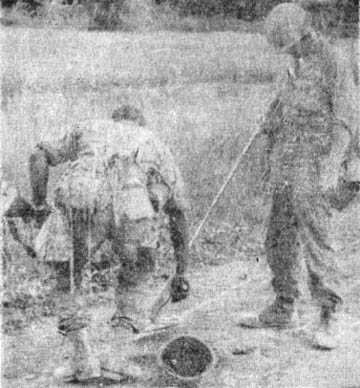 |
DANGEROUS FIND - The “pip-pip-pip” of a mine detector reacting to buried metal brings a careful probe from the 65th Engr on a road-clearing mission during Operation “Attleboro.” (Photo by PFC John R. Dittmann) |
Osaka Orphanage Fund Zooms As 1/27th Remembers Sergeant
Members of one Division rifle company have donated nearly $2400 to an
orphanage in Japan in memory of their recently killed first sergeant, a staunch
supporter of the home in the past.
1st Sgt. Samuel K. Solomon, of Hawi, Hawaii, was killed by a sniper at the
battle of Dau Tieng during the first days of the recently concluded Operation
“Attleboro” in War Zone C. He had been first sergeant for Co. C, 1st Bn, 27th
Inf. “Wolfhounds.”
His unit has continuously supported the Holy Family Home in Osaka, Japan, and
many credit Sgt. Solomon for the project’s increasing success over the years.
Said one platoon sergeant, “He was the driving force behind the project. I’m
afraid donations may drop off now that he is gone.”
Apparently such fears were unfounded as the men of his company contributed an
average of more than $13 per man to the First Sergeant Solomon Memorial Fund
providing for the record breaking total contribution.
The battalion sergeant major, assessing the meaning of the large
contribution, commented that he felt it was due to respect for the man himself
rather than to his position as first sergeant.
Men who worked with him or for him alike, remembered Sgt. Solomon as a kind
and generous man who worked with all his enormous. energy to promote the welfare
of the orphans of Osaka.
Expressing the feelings of the entire company the executive officer issued
this statement: “The donations from Co. C, for the Wolfhound orphanage are in
memory of 1st Sgt. Solomon and show our desire to continue to support our
friends in Osaka in the same fine spirit that he established.”
Mortar Platoon Answers 2/14th Calls With Shells
A few hundred yards inside the perimeter of the Division’s base camp at Cu
Chi stands a sandbagged bunker. The simple, gray-brown, unobtrusive facade
belies the ant-like activity going on inside.
The bunker is the nerve center of the 2nd Bn, 14th lnf 4.2 inch mortar
platoon. The activity has been generated by a call for support by a patrol
operating in the Filhol Rubber Plantation.
The radio cracked out the simple call to action, “fire mission.” With rapid
precision the sergeant at the radio takes down the firing data given by the
forward observer in the field.
With equal rapidity and precision the horizontal chart operator reads range
and deflection from his chart and translates them into the language of the men
on the mortars.
Meanwhile, down in the mortar pits the crew chief keeps his ear glued to the
field telephone waiting for the commands. “Shell ‘H, E’ fuse quick, deflection
three six zero niner, elevation three niner five.”
In seconds the high explosive shell is “hanging” in the tube, waiting for the
final command. “Fire,” spits the voice from the phone. “Ka-woom,” echoes the
mortar as it sends its deadly load of ripping steel hissing into the lair of the
hated Cong.
And so the daily saga goes. It is the mission of the “Four Deuce” mortar
platoon to support the infantryman in the field. And support they do.
As one man so aptly put it, “The Four Deuce is our Ace in the hole.”
 |
| MIGHTY PROTECTOR - The crew of an M-48AI tank of the 3rd Sqdn, 4th Cav scans the dense woods alongside Highway 1, just outside of Cu Chi. The tank provides security for convoys traveling between Cu Chi and Saigon. (Photo by SP4 Todd C. Darch) |
7/11th Arty Fills Requests With Deadly Blasts
Viet Cong traveling through the brush surrounding the 25th Division’s Cu Chi
base camp find the going extremely rough these days.
As Capt. Michael J. Lombardo, the battalion fire direction officer noted,
“Charlie” has had a bad month. During November the 7/11th accounted for 40
enemy killed.
The best single day’s action saw 14 VC killed by artillery. This battle
began for the artillerymen when a unit of the 2nd Bn, 14th Inf “Battle Dragons”
called in for help. High explosive shells rained the trees in front of the
2/14th and the enemy firing stopped.
In a recent action, SSgt. Earl J. High, from Indianola, Ill., an aerial
observer, was flying in a light plane above the Ho Bo Woods when he spotted two
of the enemy strolling down a path. When they heard the noise of the airplane,
the VC hightailed it down the trail.
Sgt. High radioed back to Btry A which replied with a salvo. The rounds
landed directly on target and when Sgt, High made another pass over the area he
saw both of the communists sprawled lifeless among the debris of the wooded
sector.
Page 4 TROPIC LIGHTNING NEWS December 16, 1966
Decorated
| SILVER STAR (POSTHUMOUSLY) | |
|
1st Lt. Alan Perrault, Co A, 2nd Bn, 27th Inf. Sgt. Robert E. Taylor, Co A, 2nd Bn, 27th Inf. Sp4 Aaron .L. Thomas, Co A, 2nd Bn, 27th Inf. |
PFC Roy R. Blewett, Co A, 2nd Bn. 27th Inf. PFC Earl D. Hutton, Co A, 2nd Bn, 27th Inf. |
| BRONZE STAR MEDAL (VALOR) |
|
|
Col. Thomas M. Tarpley, HHC, 2nd Bde. Sgt. Wayne W. Ballard, Co A, 2nd Bn, 27th Inf. Sp4 Richard A. Stevens, Co A, 2nd 13u, 27th Inf. PFC Cartone E. Frida, Co A, 2nd Bn, 27th Inf. |
PFC Darold G. Lokken, Co B, 1st Bn, 5th Inf. PFC Clarence E.Matthews, Co A, 2nd Bn, 27th Inf. PFC Leonard E. Welch, Co A, 2nd Bn, 27th Inf. |
| BRONZE STAR MEDAL (POSTHUMOUSLY) |
|
|
Sp4 Alan F. Lucas, Co C, 2nd Bn, 27th Inf. Sp4 Paul F. Widfeldt Jr, Co C, 2nd Bn, 27th Inf. |
PFC William T. London, Co B, 1st Bn, 5th Inf. PFC Halley D. Whitlock, Co C, 2nd Bn, 27th Inf. |
| PURPLE HEART |
|
|
Sp4 Ray G. Murchison, Co C, 2nd Bn, 27th Inf. Sp4 Mickey J. Pope, Btry C, 1st Bn, 8th Arty. Sp4 Roy W. Pruitt, Co C, 2nd Bn, 27th Inf. Sp4 Ronald E. Reid, HHC, 2nd Bn, 27th Inf. Sp4 James T. Rogers, Co A, 2nd Bn, 27th Inf. Sp4 George R. Taylor, Co B, 1st Bn, 5th Inf. Sp4 James T. Williams, Co C, 2nd Bn, 27th Inf. Sp4 James D. Williamson, Co C, 2nd Bn, 27th Inf. |
PFC Ernest R. Lopez, Co A, 2nd Bn, 27th Inf. PFC Richard D. Manning, Trp B, 3rd Sqdn, 4th Cav. PFC Robert Mark, Co A, 2nd Bn, 27th Inf. PFC Kenneth R. Nealy, Co A, 1st Bn, 27th Inf. PFC Dan Price, Co. B, 1st Bn, 5th Inf. PFC Geary Rivers, Co C, 2nd Bn, 27th Inf. PFC James R. Taylor, Co A, 1st Bn, 27th Inf. PFC Gene G. Vigil, Co C, 2nd Bn, 27th Inf. |
Indianapolis Teen - Ager offers Thanks and Help to Men in VN
(Editor’s Note: This letter war written by a Brebeaf High School Junior to
the Editor of The Indianapolis Star.)
This letter is for the troops of the 25th U.S. Infantry Division, in combat
in Vietnam:
I know many of you will not have time to read this letter because you will he
fighting for s to halt the world’s worst disease - Communism.
I know you are very proud to be fighting for our great country and will
continue to do your best. I, too, would be very proud to be in Vietnam to help
you brave men of the 25th infantry Division. However, there is one obstacle
which stands in my way. I am only a 16-year-old high school student.
Like many young people in the United States, I feel I must do something to
help men in some way.
I know many of you men view the teen-agers who are not fighting with you as
juvenile delinquents. You also may see us leading some campus demonstrations
protesting the war in Vietnam. You may see us riding our big motorcycles and
wearing our shining black leather jackets. However, these young people only
make up a very small percentage of our nation’s population. There are some
teen-agers who take the time to write you and thank you for your brave and hard
tasks over there. There may also be some teen-agers who may be sitting next to
you right now reading my letter. These are the men who some day will rule the
country you are fighting for.
You may think that the people over here in the States do not appreciate what
you are doing. Many people think that the war is useless. There are probably
even some men over there who think that the war is useless. However, you know
you have a job to do and you do it without hesitation.
I would appreciate it very much if you would send me a list of things you may
need or want. I would be very happy to send you some hometown newspapers,
recent records, or anything I can do within my power. I hope you will take my
letter seriously and let me do something for you guys.
Thank you for your valuable leisure time in reading my letter.
Thank you also for fighting and possibly dying for us over in the States. I
really want to do something for you so please grant me any request and I will
see what I can do.
CHUCK BERRY
Indianapolis
Editorial
They Chose Freedom
Thomas Paine and Patrick Henry came from very different backgrounds, but they
shared one thing in common - a love of freedom.
To them, this freedom was worth as much as life itself. It is often
worthwhile for Americans of this day and age to reflect on the contributions our
forefathers made in order to preserve the ideals many of us now take for
granted.
Thomas Paine, on Englishman by birth and the son of a poor family, fled to
America in 1774 to escape the tyranny of King George III. Early in 1776, Paine
wrote a pamphlet, “Common Sense,” which had a tremendous effect in mobilizing
colonial opinion and bringing about the Declaration of Independence.
Throughout the war, Paine wrote inspiring newspaper pieces which he titled
“The American Crisis,” or simply the “Crisis” papers. These two were a potent
force in the cause of freedom. Paine’s writings sustained morale and created
hope when American fortunes were at a low ebb.
Patrick Henry, on the other hand, was a wealthy trial lawyer and land
speculator just prior to the Revolution. Largely self educated, he quickly
became a leader among the citizens of Virginia and spoke out for individual
freedom on every occasion available.
As on orator, he had no equal. His words, “Give me liberty or give me
death,” are familiar to all Americans.
Today, we can learn much from these two men and the countless thousands like
them. Our forefathers showed us the necessity of preserving our freedom and
sharing it with others.
As advocates of freedom, Thomas Paine and Patrick Henry never faltered in the
belief that their cause was just and their duty clear. Their choice was
freedom, and they stuck to it.
Westmoreland Urges Cutdown On Reckless Piaster Spending
Gen. W. C. Westmoreland, commander of United States Armed Forces in Vietnam,
this week called for a sharp reduction by all personnel and agencies in the
spending of piasters.
Citing the economic hazards which result from continued uncontrolled flow of
piasters into the Vietnamese economy, Gen. Westmoreland directed his staff and
component commanders to institute an aggressive and dynamic program directed
toward the reduction of piaster expenditures. Specifically the program will
lessen the inflationary impact of our presence upon the economy of Vietnam.
Programs are to be aimed specifically at controlling the official-rate
piasters spent by DOD agencies and their contractors, “Assistance in Kind” (AIK)
expenditures, and personal spending by the military and U. S. and third country
employees of contractors.
While there are no plans at present to limit the number of piasters
individuals may purchase at the accommodation rate of exchange Military Assistance
Command, Vietnam (MACV) has called for a personal, self-imposed limitation on
piaster expenditures.
Leading the list as the most painless way to reduce personal piaster
purchases is to increase deposits with the Uniformed Services Savings Deposit
System. This program especially designed for men overseas, pays the individual
10 percent on deposits up to $10,000. Also high on the list of positive
controls on personal spending are the 5 percent interest, no-cost checking
accounts of the Bank of America and the Chase Manhattan Bank now operating in
Vietnam. In addition, the United States Savings Bond program continues to offer
another painless way to put money to work while increasing personal savings.
The objective here is to have the soldier get his money out of Vietnam into one
of the savings programs or through the allotment system.
Among the personally less desirable suggestions being considered are earlier
curfews, reduction in passes and increased use of the “off limits” designation.
It is recognized by officials that personal efforts alone will not completely
achieve the desired level of reduced piastcr expenditures. For this reason
officials have directed all contracting agencies to take a close look at
operating methods and establish effective programs to reduce piastrr expenses.
Among areas under consideration are increased logistical and special support for
laundries, PX, movies, hobby shops, USO, Red Cross and supervised athletic
programs.
Relocation of military personnel and agencies to new facilities and troop
cantonment areas outside the Saigon metropolitan area will be accelerated.
Personnel residing in private billets, leased apartments and hotels can
anticipate relocation to troop areas as quickly as facilities become available.
Numerous other proposals for controlling expenditures of piasters are under
consideration. These will be reported on if and when they are adopted. In the
meantime, Chairman of the MACV Piaster Expenditure Control Working Group, Col.
Paul A. Wedlan, stated that his group welcomes constructive suggestions, from
individuals or agencies, which contribute to the success of the program.
| The TROPIC LIGHTNING NEWS is an
authorized publication of the 25th Infantry Division. It is published
weekly for all division units in the Republic of Vietnam by the
Information Office, 25th Infantry Division, APO U.S. Forces 96225. Army
News Features, Army Photo Features, Armed Forces Press Service and Armed
Forces News Bureau material
are used. Views and opinions expressed are not necessarily those of the
Department of the Army. Printed in Saigon, Vietnam, by The Vietnam
Guardian. Maj. Gen. Fred C. Weyand . . . . Commanding General Maj. William C. Shepard . . . . . . Information Officer 1st Lt. William H. Seely III . . . . Officer-in-Charge Sp4 David L. Kleinberg . . . . . . . Editor Sp5 Jimmy Edwards . . . . . . . . . Editorial Assistant Sp4 Adrian E. Wecer . . . . . . . . Editorial Assistant |
Page 5 TROPIC LIGHTNING NEWS December 16, 1966
$25 Prize
1st Bde PFC Wins Div. Combat Photo Contest
PFC Lawrence A. Craig of HHC, 1st Bde, was awarded first prize and $25 in the
division’s Combat Photography Contest sponsored by Division Special Services.
PFC Craig won the first-place prize of $25 for his 3” x 5” color print of a
3rd Sqdn, 4th Cav, tank securing Highway 1.
The second-place prize of $15 was awarded to PFC Patrick Davis of Btry A, 3rd
Bn, 13th Arty for a color slide showing division helicopters firing at a
suspected VC location.
Capt. David G. Crane of HHC, 25th Div., won the third place award of $10 for a
4” x 5” black and white shot at a division MEDCAP.
1st Lt. William H. Seely III, 25th Admin Co, took fourth place and $10 for a
5” x 7” color print of a door gunner on guard.
Jungle Becomes Quick LZ
Recipe for a landing zone (LZ)?
Take one bomb crater, and two platoons of engineers from Co. D, 65th Engr Bn,
four tons of explosives, and stir with chain saws. That’s the combination that
worked on LZ-510-Alpha, the landing zone or the tactical command post of the 1st
Bn, 35th Inf, in the central highlands of Vietnam.
Hacked from the dense jungle, Zone-510-Alpha is now large enough to hold six
helicopters at one time, in addition to the tactical command post and an
artillery unit of the 2nd Bn, 9th Arty.
The trees in the landing zone were primarily mahogany, up to four and five
feet thick and towering more than 100 feet.
For an encore, the engineers, commanded by Capt. John E. Stetzinger, took a
few of the mahogany trees, built a bridge across a creek bordering LZ-510-Alpha
and built another four-ship landing zone.
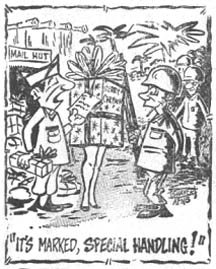 |
Boy Sends ‘Kool’ Aid
Eleven-year-old Jeffrey Waits of Wilmington, Ohio, is a special kind of
American boy who wanted to do something for the American soldiers fighting this
special kind of war.
With the help of his mother, Jeffrey prepared a package and letter to a
soldier who had been in combat and did not receive much mail. The pakage
contained numerous goodies, including Kool-Aid, since he thought the water here
wasn’t too tasty.
When the package arrived at the home of the “Gimlets,” 3rd Bn, 21st Inf,
196th Lt. Inf. Bde., it was sent to Co. C. Capt. Russell DeVries, Co. C
Commander, presented the package to PFC Joe Mrziock of Whiting, Ind. For the
members of his squad.
Capt. DeVries conveyed the men’s thanks to Jeffrey in a letter.
MPs Aid Downed Helicopter
By Lt. Richard Steirhausen
The airstrip was a beehive of activity. For hours airplanes and “Chinook”
helicopters had been pouring in supplies and ammunition for the troops on
Operation “Attleboro.”
Sp4 Brian E. Anderson stood at his post directing traffic and watching for
civilians crossing the air field during the heavy traffic. He was one of the
Military Policemen from HHC, 196th Lt Inf Bde, assigned to provide security and
traffic control during the operations near Dau Tieng.
A nearby ‘Huey’ took off, heading out of the village. It appeared to lose
power and suddenly plunged to earth and burst into flames.
“I saw the billowing clouds of smoke and I started to run toward the MP shack
to get help,” Specialist Andersen said, “I yelled to a couple of my buddies who
came running over and we piled into the jeep and raced over to the accident.”
“When we reached the wreck some fellows were carrying one of the crewmen into
a helicopter. Sgt. Wayne Reed of Akron, Ohio and Sgt. James B. Dalton of
Framingham, Mass., started tossing buckets of water on the blaze, while PFC
Robert Salmy of Unadilla, N.Y., kept the crowds away from the blazing cauldron.
When the buckets proved useless we grabbed small fire extinguishers and tried
to contain the flames.”
Sgt. Reed recalled, “It was too darn hot. I wanted to get away from the
flames, but I knew if we did the fire would spread to the nearby huts and
possibly burn down half of the village.”
The MPs fought the blaze for 10 minutes until a fire truck from the village
arrived with hoses. Refusing to leave the scene until the job was finished they
manned the hoses with the Vietnamese firemen and together extinguished the
deadly flames.
The villagers nearby cheered and shouted for the heroic “firefighting”
policemen of the “Chargers” brigade.
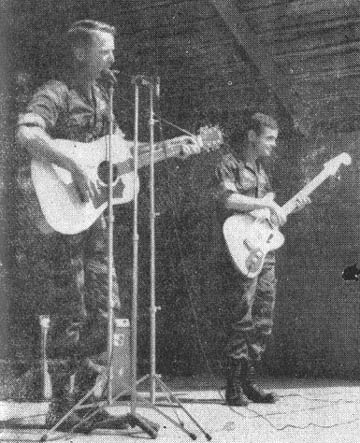 |
PATCHES A GO - Capt. Hershel Gober, (l) and Sp4 Jimmy Tobias, members of the Black Patches, a military entertainment group touring Vietnam, stops briefly at Cu Chi to entertain 25th troops at the “Lighnting Bowl.” |
|
|
Page 6-7 TROPIC LIGHTNING NEWS December 16, 1966
[This issue of Tropic Lightning News was scanned from a bound library volume provided by the 25th Infantry Division Museum. Three of the photographs. their captions, and one full column of text on pages 6 and 7 were printed across the center of the 2-page-wide sheet and partially hidden from sight - the book could not be safely opened wide enough to see that part of the page.]
Blow Up a Big M-U-S-T For 196th at Tay Ninh
In the ever present fight to bring increased, more effective medical
service to the man fighting in the field, the Army’s most modern combat medical
facility, the 45th Surgical Hospital, is now operational at the 196th Lt Inf Bde
at Tay Ninh.
It is the first military service surgical hospital to use the new Medical
Unit Self-Contained Transportable (MUST) equipment. Under control of the 1st
Log Command, the new hospital is commanded by Maj. Charles M. Lyon.
[paragraph is missing in the center fold of the page]
of a combination expandable shelter-shipping container; an inflatable shelter
for hospital wards; and a utility system which provides electrical power, air
conditioning, heating, hot and cold running water, and waste service. Its
elements are compact, lightweight, and easily movable and by combining equipped
functional elements, can be assembled into the various types of field hospitals.
Each hospital ward shelter holds 20 patients in air conditioned comfort. It
can be erected in 30 minutes by inflating a series of inter-connected tubes with
air pressure from the jet-engine powered utility pack.
The expandable container features modern facilities for performing the most
complex and delicate operations, yet can be folded into a compact package which
serves as a shipping container holding all equipment. It can be carried by a 2
1/2 ton truck, cargo aircraft, helicopter, or can he mounted on detachable
highway transporters for towing.
The 45th Surgical Hospital received its MUST equipment at Ft. Sam Houston,
Tex. in June 1966. The facility is staffed with over 100 personnel including
physicians, nurses and enlisted corpsmen.
| SURGERY - Surgeons, using the most modern equipment, can perform even the most complex operations at the new MUST hospital at Tay Ninh. (Photo by Garrett Corp.) |
 |
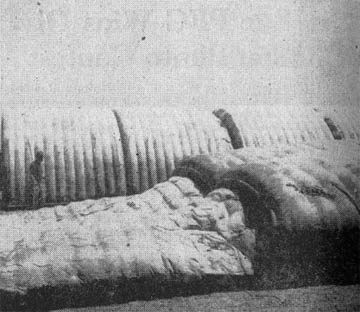 |
INSTANT HOSPITAL - The new lightweight, highly mobile hospital consists of inflatable buildings which house wards and treatment facilities. eve ar below are portions of the hospital being erected. (Photos by 7th PI Det) |
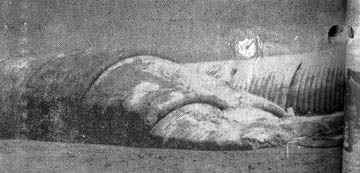 |
|
 |
CONNECTION COMPLETE - A soldier zips up an interior connecting panel in a MUST hospital ward shelter. (Photo by 7th PI Det) |
| INSPECTION - A soldier inspects the air pressure valve and exterior of a MUST hospital ward shelter. (Photo by 7th PI Det) |
 |
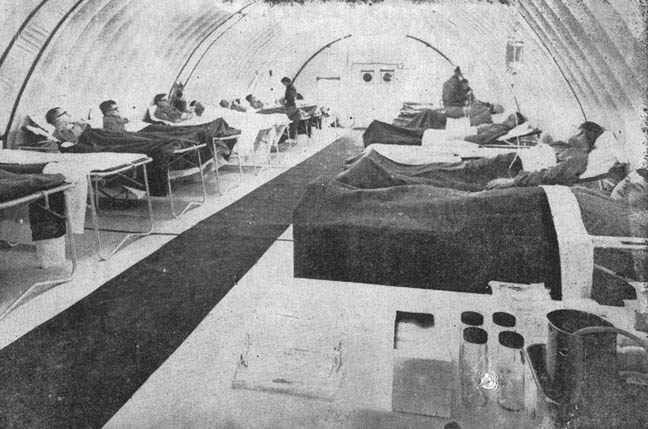 |
| COMFORT - Patients can recuperate in air conditioned comfort at the MUST hospital wards. Each inflated ward can accommodate 20 patients. (Photo by Garrett Corp.) |
 |
| COMMANDER LEADS - Maj. Charles M. Lyon, commander of the 45th Surgical Hospital, directs men as they prepare to erect a MUST ward shelter. (Photo by 7th PI Det) |
Page 8 TROPIC LIGHTNING NEWS December 16, 1966
VC Fights 15 Years, Then Quits
A man we’ll call Mr. X entered the village of Tan Phu Trung. He stopped at a
small house on the outskirts and sent word to the chief that he wished to join
the Chieu Hoi (open arms) program.
Immediately, the chief sent popular forces personnel to the dwelling to
escort Mr. X back to headquarters. To show his true faith, Mr. X turned over a
pistol to the popular forces.
Mr. X was interrogated by the village chief and Capt. Archie L. Dowdell,
civil affairs officer for the 1st Bn, (Mech), 5th Inf. Shortly after Mr. X was
ushered away to the Chieu Hoi camp at Bao Trai. Here is his story of how he
became a Viet Cong and why he decided to quit.
“When I was 19 years old I was very dissatisfied with the way the French were
running things in Indochina. I decided there must he a better way and looked
for it. Shortly thereafter, I came in contact with elements of the Viet Minh.
The group, headed by Ho Chi Minh, was determined to overthrow the French. I
joined in 1950 and fought against the French until their ultimate defeat at Dien
Bien Phu some four years later.”
“Indochina was then split up into four separate countries: Laos, Cambodia,
North and South Vietnam. Being a South Vietnamese, I stayed in the south and
went back to my farming.”
“In 1956 Ho Chi Minh told us to rise up and unite the two Vietnams. For five
years I fought the South Vietnamese Army and on the sixth year I fought the
Americans. We were experts in jungle fighting with our vast knowledge gained
through experience.”
“In 1962 I went to North Vietnam for special training and became an Artillery
officer. I stayed there and worked until 1965 when I was ordered to return to
the South and set up propaganda and security operations in the vicinity of Cu
Chi.”
“It was my job to go into a village in my area, gather the people about me
and explain what the Vietcong did and why. I would attempt to indoctrinate them
into the communist way of thinking.”
“Recently the American artillery killed some of my friends and the Americans
soldiers were closing in on me too fast so I decided to turn myself in.”
| A MOMENT OF PRAYER - Chaplain (Maj) Michael Filip, chaplain of the 3rd Brigade Task Force, conducts Mass for men of the 1st Bn, 14th Inf “Golden Dragons” in the field. |
 |
Modern Facilities
12th Evac Is Ready
Amid the many improvements and additions that have appeared in the Cu Chi
base camp is an elaborate medical facility designed to render immediate service
to any soldier operating in the area.
The newly opened 12th Evacuation Hospital located at Oahu and Taro Roads, is
staffed by 98 officers and 214 enlisted personnel. The 33 assigned doctors
provide a professional staff which can perform any type of surgery and
diagnostic service.
The unit provides everything for the care and comfort of the patient,
including messing, transportation, temperature control, electrical power,
telephone and teletype communications, laundry facilities, disinfection and
shower units, repairs and utilities, and even road building.
The 400-bed hospital will enable maximum recuperatory time to the individual
patients, thus eliminating the necessity to evacuate some of the more serious
cases out of the base camp. This will directly reduce the delay in returning a
patient to duty.
An organic dental clinic, capable of performing facial or oral surgery, is
attached to the new medical facility. Dental care for hospitalized patients, as
well as for the hospital staff, is available.
The 12th Evacuation Hospital, whose motto is “Be the Best,” was located at
Fort Ord, Cal., prior to moving to Vietnam and has a record of service dating
back through both World Wars.
The hospital will work in conjunction with the 25th Med Bn and 7th Surgical
Hospital, both located at Cu Chi.
Lt.’s Call Brings on Artillery Teamwork
Teamwork of all kinds is important in a combat situation, but the artillery
units of the 25th have an unusual method of working together on aerial
observation missions.
1st Lt. Donald C. Parcells and his latest flight is a good example. The
lieutenant, who calls Oradell, N.J., his home is the ammunition officer,
assistant fire direction officer and an aerial observer for the 7th Bn, 11th
Arty. But on a recent mission he called on Btry A, 3rd Bn, 13th Arty.
The target was a group of suspicious Viet Cong running back and forth from a
rice cache. When Lt. Parcells dropped the small plane lower for a better look,
the enemy took off. Seconds later 155mm artillery shells from the 3/13 began
chewing up the terrain.
Lt. Parcells said he saw trees being chopped up and knocked down right in the
spot where the VC were last seen. Three of the communists were found motionless
among the shattered brush.
As this mission was being carried on, Lt. Parcells unit back at Cu Chi was
firing support for an aerial observer with the 2nd Bn, 82nd Arty.
A “Friendship House” Wins Friends for U.S.
In a situation where it is all too possible to be among enemies, the spirit
of the 25th Division’s Friendship House is quite refreshing.
Friendship House is less than a hotel but more than a barracks; it charges no
rent but the annual returns are beyond calculation; it is located on a military
reservation but it is designed with a decidedly civilian outlook.
First conceived by Lt. Col. Robert R. Hicks, 44, of Savannah, Ga., the house
is intended to provide temporary quarters for Vietnamese guests of the “Tropic
Lightning” Division. Guests live in the comfort of an all-wooden building with
a tin roof. They have at their disposal reading material, a radio, wash
facilities, fresh water and a choice or either oriental-style floor mats or Army
cots for the night.
Room service provides three hot meals a day, on the American plan.
Service, Recovery Section Keeps Busy
The Service and Recovery Section of Co. B, 725th Maint Bn, staffed by a
platoon of 33 men handles the recovery of disabled vehicles from the division -
and it can be quite a task at times.
“Our job takes us into the rice paddies to retrieve a personnel carrier or
tank that has been demobilized by an anti-tank mine, on the open highway or
secluded village road to hoist out a truck that is bogged down in mud, or right
inside the base camp to up-right a fuel tanker,” said SFC Milton D. Johnson.
The term service takes in a variety of operations, including welding, machine
work, metal fabrication, and body and fender repairs.
The shop is equipped with three main types of welding apparatus: heliarc for
welding aluminum and other non-ferrous metals; oxyacetylene for light welding
and brazing jobs; and arc welding for joining heavier metals.
A machine shop, complete with lathe, drill press and shaper, makes it
possible to manufacture many parts essential to the repair of a vehicle which
are not readily accessible through supply channels.
With many types of metal ranging in a wide variety of sizes, shapes and
alloys at their disposal, the section is able to fabricate numerous items which
will improve their living and working conditions.
Two other facilities available at the service and recovery section are a
canvas shop and a glass shop. Here the S&R men repair all seats, truck tops,
windshields and window glasses that are turned into the 725th maintenance.
| PUFF THE UGLY DRAGON - A CH-47 Chinook from the 52nd Avn Bn, hovers over a 3/4-ton truck while a soldier from the unit hooks the sling to the hook under the aircraft. The photo was taken during Operation “Paul Revere IV.” |
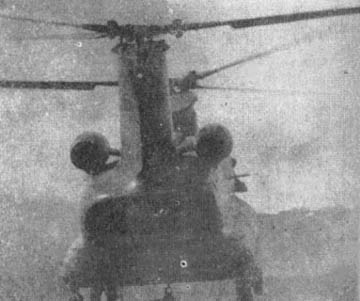 |
Page 9 TROPIC LIGHTNING NEWS December 16, 1966
TROPIC FLASHES
![]()
2/14th
Lt. Col. W. Davis, CO
Capt. D. Moore, IO
”Battle Dragons”
Several changes of command took place during recent ceremonies within the
battalion. 1st Lt. Charles E. DeWese, formerly Heavy Mortar Platoon leader, now
commands a platoon of Co B. 1st Lt. Michael R. Rapauno meanwhile has assumed
leadership of the Mortar Platoon.
1st Lt. Stanley Yates has been appointed as Co B executive officer after
serving as a battalion Reconnaissance Platoon leader. Replacing Lt. Yates in
the Recon Platoon is 1st Lt. Dale R. Crafton.
Now in their second month in VN are 1st Lt. Elliot L. Winkler Jr, a platoon
leader for Co A, and 2nd Lt. David A. Cope, Co B platoon leader. 2nd Lt. Willie
E. Maxwell Jr. has now taken over the company’s weapons platoon.
The Battle Dragons wish to express their deepest sympathy to Capt. Neal J.
Senkus of Co C. The poor captain had to pack his bags and leave the unit for 60
days of unfortunate temporary duty at the Bankok R&R Center!
A tip-of-the-hat to nine new sergeants from the men of the battalion. They
are Nathaniel Alicea-Rios, Calbert E. Allen, Robert L. Goforth, Ronald S.
Harrison, Johnny Holloway Jr., Aaron D. Hunt, Virgil V. Kass, Richard V. Koleff
and Carl L. Watson.
Plans for a permanent enlisted men’s club are in the making, replacing the
temporary club now in use. Completed just before Thanksgiving, the temporary
club was termed an “overwhelming success” by SSgt. Angel Dela Cruz, club
manager.
The men of Co C feel pretty safe with Psgt. Bennie J. Shelby near-by. A
Korean War veteran, the sergeant holds the Distinguished Rifle Badge, the
highest award for excellence in competition with a service rifle, the M-1. Sgt.
Shelby has participated in many championship matches and in 1953, won the
All-Army rapid fire championship while setting a record for the event.
![]()
Div Arty
Col D. Williams, CO
Maj. E. Standeven, IO
The annual division artillery ball was held Dec. 3 at Artillery headquarters
officer’s club. Nurses and doctors from the 12th Evac Hosp and 7th Surg Hosp
were honored guests. Entertainment was provided by the Division combo band.
The highlight of the affair was the presentation of orchids, specially flown in
from Hawaii, to the ladies present.
Artillery headquarters has high hopes of having a new chapel by Christmas.
At present the construction site is empty but soon artillerymen will be building
a cement floor and walls and a thatched roof will be erected. A bell for the
new chapel has been bought and donated by Col. Daniel B. Williams, Div. Arty.
commander.
![]()
65th Engr En
Lt. Col. C. Strider, CO
Capt. S. Crow, IO
After a six year separation, two “Tropic Lightning” soldiers got together for
the same purpose, which brought them together in 1960, but under somewhat
different circumstances.
The meeting took place at the Mines and Booby Traps School. The occasion was
the re-enlistment ceremony for Sgt. Sterling R. Moore of the 65th.
Among the several persons attending the brief ceremony was Sgt. William H.
Hummer of the Divisions re-enlistment office. Sgt Hummer had signed Sgt. Moore
for re-enlistment at Fort Leonard Wood, Mo., six years ago.
As the two men reminisced over the past years, it was apparent that many
things were unchanged. Six years ago Sgt. Moore was an instructor as he is now
and Sgt. Hummer was working in re-enlistment. “This time,” stated the engineer,
“Sgt. Hummer had to travel a few thousand miles to sign me up. Six years ago
both men were staff sergeant and now both are sergeants first class.
Sgt. Moore, who is assigned to Co. A, also served with the 65th during the
Korean War.
![]()
196th Lt Inf Bde
Brig. Gen. R. Knowles, CG
Capt. M. Randall, IO
”Chargers”
The honorable Mr. Alejandro Almendras, a senator from the Republic of the
Philippines, visited the 196th base camp at Tay Ninh, recently.
Sen. Almendras arrived with Brig. Gen. Gludencio Tobias, commander of the 1st
Philippine Civic Action Group, Vietnam (PHILCAGV) stationed at Tay Ninh.
The senator was given a briefing and discussed issues at hand with Brig. Gen.
Richard T. Knowles, 196th commander.
Sen. Almendras’ visit was concluded with a tour of the base camp and the city
of Tay Ninh.
![]()
25th Avn Bn.
Lt. Col. E. Davis, CO
Maj. D. Winters, IO
”Little Bears”
The infamous hooch known as the Bamboo Lounge Raiders have their first VC KIA
confirmed by body count. Credentials identifying him as Ho Chi Mouse, the lone
enemy had become notorious during recent weeks for his raids on exotic cheese
and clean T-shirts. After a thorough analysis of the situation, a plan was
hastily conceived - the “Last Resort” weapon would be used. The famed Victor
Brand Mouse Trap and a little mess hall cheese proved to he too inviting for Ho
and fell into the ambush. He met his death approximately 3:30 p.m. on November
27. He was given a full military funeral by the occupants of the hooch as any
tenacious and wily foe deserved. Burial was in the battalion’s trash dump.
The Diamond Head Light Construction Co. has completed projects at the mess
hall including a new annex.
The aviators extend congratulations to Talmadge Dobbs who was recently
promoted to sergeant.
VC Get Hot Meal; 2/1st Saves Captive
The “Guardians” of Co. A, 2nd Bn., 1st Inf. treated a group of Viet Cong to a
“hot breakfast” recently while operating northwest of Tay Ninh.
Co. A also rescued a Vietnamese captive during the same action. PFC Bobby J.
Pendergrass of Queens, N.Y. recalls:
“We were sweeping through some thick jungle covering about 5000 yards.
Traveling nearly 2000 yards, we came into a clearing. We noticed a few men
sitting down, apparently eating breakfast.”
“Moving closer to the unsuspecting party, we heard one of them yell,
‘Yanks!’ They were Viet Cong. But our arrival took them so much by surprise
that they left two weapons laying against a tree.”
“There was a fire fight which lasted about three minutes, and we killed one
VC. We suffered no casualties.”
The dead VC, wearing an expensive watch, and carrying a .44 caliber pistol
was believed to be an officer.
A search of the area uncovered two bicycles, two small arms weapons, and
numerous other items, including gas mask and pistol belts.
| FENCED IN – Lovely Jean Carroll pauses at a rustic spot as she takes in the sun. Jean is an amateur sports enthusiast and was last year’s Tournament of Champions Queen. |
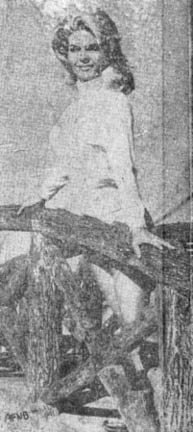 |
New Commander Arrives at 2/1
Maj. Stephen E. Nichols is the new commanding officer of the 2nd Bn, 1st Inf
at Tay Ninh. He was formerly assigned to HHC, 173rd Airborne Bde.
Maj. Nichols is a 1952 graduate of the U.S. Military Academy at West Point,
N.Y. He holds a master of science degree from George Washington University in
Washington, and has studied briefly at the Alliance Francaise in France. In
1958, the Major was a French instructor at the USMA.
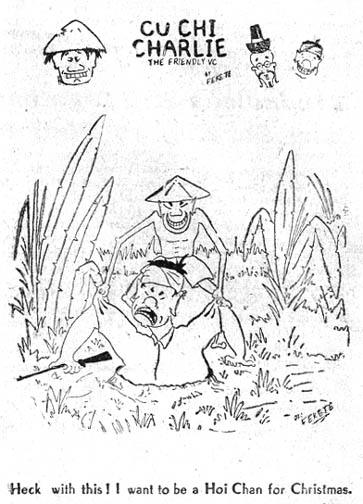 |
Page 10 TROPIC LIGHTNING NEWS December 16, 1966
Attleboro Action
Sgt. Gets Silver Star
Sgt. Lester Armstrong of the 3rd Bn. 21st Inf, has been recently awarded the
Silver Star for heroism under fire during Operation “Attleboro.”
Elements of the 2nd Bn, 27th Inf, “Wolfhounds” were pinned down by an
estimated battalion-size enemy force in the jungles north of Tay Ninh Province.
Reinforcements were needed quickly.
The 196th Lt Inf Bde received an urgent call for assistance and within
minutes Co C, 3rd Bn, 21st Inf, was sent in for the rescue.
During the search and destroy operation with Co C, Sgt. Armstrong’s platoon
was pinned down by enemy machine gun fire from a bunker to their front.
The dense jungle undergrowth made movement almost impossible. In the maze of
vines and roots Sgt. Armstrong’s machine gunner became entangled and could not
move forward with the rest of the platoon. Realizing the importance of the
weapon for protection, the sergeant rushed through enemy fire toward the
soldier, picked up the gun and he and another platoon member assaulted the
bunker.
Hit in the arm and leg by burning grenade fragments the Missouri native
increased his fire and wiped out six VC as they scurried for cover. Then
concentrating his fire on the machine gun bunker, he quickly knocked out the
three VC in that position.
Sergeant Armstrong’s platoon continued without further casualties.
Unit Gets Juke Box From N.Y. Residents
125th Signal Battalion, without even asking, received a jukebox complete with
records. The generosity of the people of the greater Island Park, Long Island,
N.Y., area was so tremendous that the soldiers of this “Tropic Lightning”
Division unit still find it hard to believe.
The men had little to look forward to on their off duty time as far as a
place to relax went. Then the battalion built an enlisted men’s club. Although
the building was comfortable inside and had an air of relaxation to it, the
silence was deafening.
During this time, the club’s custodian, Msgt. Andrew J, Ziemba, wrote his
brother Albert in Island Park, describing the club and its problem. Sgt. Ziemba
mentioned the need of a record player.
Time passed and then a letter came from brother Al saying that of all things,
a jukebox would be on its way shortly.
Brother Al, meanwhile, was enlisting the aid of the town newspaper, radio
station WTHE in Garden City, Long Island, and a television station. He also
staged benefit dances to raise the necessary funds for shipping costs and
records. Mr. Sandy Moore, a New York City music distributor, had already
donated an $800 high fidelity jukebox.
Station WTHE picked out 250 new top rock’n'roll and western records while an
Island Park packing company crated the jukebox free.
As for the men of the 125th Signal Battalion? They sent Albert Ziemba and
his wife a dozen red roses and an appreciation card. To the Island Park city
hall went a dozen bird-of-paradise flowers and a letter of appreciation. Mr.
Moore was sent a letter of thanks.
The radio station received a special present. Every man present at Cu Chi,
assigned to the 125th, signed his name and hometown on a long sheet of teletype
paper expressing their gratitude.
The staffs of the 12th Evac Hospital, 7th Surgical Hospital and all patients
able to come are invited as honored guests of the club.
This example of concern on the part of the people of island Park came a long
way to Vietnam and will go a long way to cheer a great many soldiers in the
months to come.
| AIRBORNE - A powerful CH-47 Chinook helicopter lifts a UH-1D chopper which was disabled while supporting the 1st Bn, 14th Inf “Goiden Dragons” a during a recent operation in the central highlands. (Photo by Sgt. Michael N. Horowitz) |
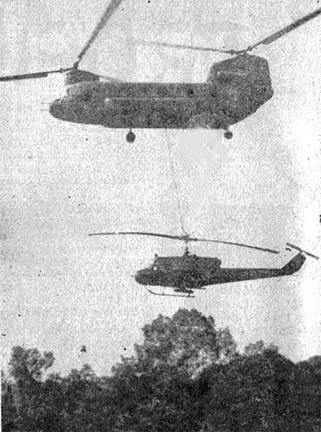 |
Boxer Scores a Musical Smash At 196th Command Performance
PFC Richie Moore, a rifleman for Co C, 3rd Bn, 21st Inf, can just as easily
win an expert badge behind a microphone. Recently, he and his musical group,
“The CIB,” played at a command performance before the brigade commanding general
and his staff.
Brig. Gen. Richard T. Knowles was entertained with such hits as “The CIB” and
“Jolly,” a familiar cadence-calling song set to calypso, both of which PFC Moore
has composed.
The group consists of Sgt. Charles A. Medieros Jr. and PFC Terry H. Fogely on
guitar; SSgt. Lawrence F. Mokulohua on bongos; and PFC Gordon Green on drums.
Backing up with vocals are Sp4 Reginald Long and PFC’s Carl King and Albert L.
Lester.
Center of all attention at the general’s dinner show was PFC Moore’s new
song, The CIB, which was inspired by Co C’s participation in Operation
Attleboro. Capt. Mitchell L. Leeds, PFC Moore’s commander and manager, is
having the song copyrighted and plans to make it into a commercial recording.
PFC Moore started singing for audiences by winning an elementary school
talent show back in his hometown, Detroit.
Multi-talented, the rifleman holds the Fort Devans, Mass., Lightheavyweight
boxing crown and here the Co C, PT trophy.
Along with Capt. Leeds, he credits his Army success to Maj. Harold L. Coop
Jr., the brigade adjutant, who writes the music to his songs and Lt. Col.
Charles K. Nulsen 3/21st commander, whom PFC Moore says, has given him a lot of
support.
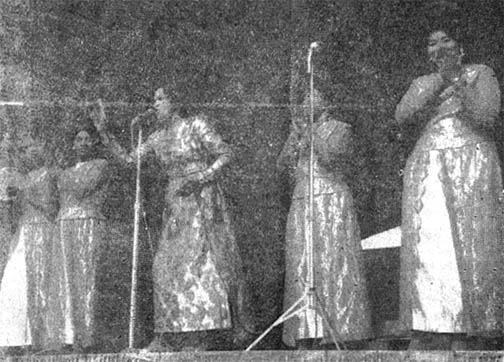 |
| HOLIDAY HIT - The Clara Ward Singers, a negro spiritual group, entertain troops of the Division during a Thanksgiving Day appearance at the “Lightning Bowl." |
3 Inductees Still Together Now Serving as Gimlets
Thousands of miles separate Galien, Ohio, and Tay Ninh Province. But these
long miles could not separate three soldiers of the 3rd Bn, 21st Inf, “Gimlets.”
Sp4’s John M. Fisher and Richard C. Melchoir and PFC Michael Plummer, all of
Galien, received their induction on the same day. And they all completed basic
training at Fort Devens, Mass.
All three were sent to Camp Drum, N.Y., and last May completed advanced unit
training. Three months later and the “inseparable buddies” were still together
- not at such plush surroundings as Fort Devens, but instead in the steaming
jungles of Vietnam, thousands of miles from their hometown.
Now more than ten months since induction Specialist Fisher, a medic with Co
B, has been awarded the Combat Medical Badge and has participated in Operation
“Attleboro.”
Specialist Plummer, meanwhile, is serving as an ammo bearer with the
anti-tank platoon of Co D.
An outstanding graduate of advanced individual training, Specialist Melchoir
is a battalion clerk.
Page 11 TROPIC LIGHTNING NEWS December 16, 1966
Part 3; Helping Hand
Know Your Division
By Sp5 Wayne Brendt
What started out as a desolate looking peanut patch is now a thriving complex
dedicated to the belief that people who care can bring new hope into the lives
of those who have nothing.
This is the home of the division’s “Helping Hand” Program. The sign outside
the Helping Hand’s base of operations is appropriately a huge hand reaching out
to assist the Vietnamese people.
In the beginning the “Tropic Lightning” Division got a big head start, as the
warm hearts of the people of Hawaii went out to the Vietnamese villagers they
had never seen. When the troops left Hawaii for their new assignment in Vietnam
more than 350 tons of assorted goods came along.
With this “ammunition” the Helping Hand concept of operations was ready for
action the day it arrived at its Cu Chi base camp. With most other civic action
programs, international agencies such as United States Aid for
International Development (USAID) and CARE have to be contacted to get their
program materials. Helping Hand, however, had its goodies all boxed and ready
to roll.
59.000 Helped
Since March 1966 the peanut patch workers have assisted 59,000 Vietnamese
people. The Medical Civic Action Program (MEDCAP) portion of Helping Hand has
treated more than 57,000 persons. In addition there is enough left of the
originally donated materials to last for some time.
Another little known fact is that when the program was started it had $5800
in donated funds to use to assist the program’s efforts. One small portion of
the fund went to provide 18 wonderful Mid-Autumn Festival parties for 4,000
children in four provinces around the Division’s base camp. Cakes, lanterns and
soft drinks made uncounted new friends that day while numerous parents looked
on, wide eyed, at this unexpected display of American love for children.
A typical request for Helping Hand materials would proceed in this manner: A
unit of the 25th, operating in the field, notices a need. After coordination
with local Government, the need is transformed into a written request that
speeds through channels to the Helping Hand Operations Center where the request
becomes a box of materials.
The unit involved receives a telephone call and the items are picked up,
transported to the required area, and the need is filled. The result is another
group of Vietnamese villagers helped, swiftly and without needless delays in
paper work. In fact, the speed with which Helping Hand works sometimes even
amazes the Americans involved.
Specialized Kits
Another thing that is amazing is the materials that make up Helping Hand.
There is almost a little of everything. The Operations Center has stocked huge
amounts of clothing for all ages, toys, books, tools, health and sanitation
items (tooth paste, tooth, brushes, combs, wash cloths, towels, and soap), as
well as canned goods of all types. The materials are made up into kits which
fulfill specific needs.
Some of the kits include one for refugee families (a rice cooker, fry pan,
soup base, two water buckets and cooking utensils); individual refugee kit
(sleeping mat, rice bowl, chop sticks and cup); woodworking kit (rip saw, cross
cut saw, large claw hammer, plane, chisels, drill bits and a drill); school kit
(note books, pencils, ruler, pens, chalk, erasers, some slates and a plastic bag
to carry the things in); and a condolence kit (articles of clothing, toys,
shower shoes, bag of rice, health and sanitation items, canned goods and
leaflets (explaining how to cook American foods). The condolence kits are used
to aid victims of Viet Cong terrorism attacks and families of Vietnamese
National Policemen killed on duty with the Division.
The refugee kits are issued out whenever the division receives refugees in
connection with operations and whenever the refugees are without the basic
necessities of life.
Training
One unique sidelight to Helping Hand is its vocational training programs.
Donated sewing machines are being used in local schools to establish sewing
training classes. High school age girls and some adults are given this home
economics education. The machines are loaned out to various schools as the need
occurs. Without these machines, many young girls in the area would not have a
chance to learn this valuable skill.
 |
HELPER - Maj. William W. Walker III, assistant civil affairs officer for the division, displays a Helping Hand Refugee Kit. |
|
Radio And TV |
| 6:30 | News Headlines Information Please |
8:00 | Gunsmoke |
| 7:00 | Addams Family | 9:00 | Danny Kaye |
| 7:30 | News | 10:00 | The Tonight Show |
|
SATURDAY - Dec 17 |
| 1:30 | News Headlines Social Security Encyclopedia |
4:30 7:00 7:30 |
Football Game Sportsmans Holliday News |
| 2:00 | M-Squad | 8:00 | Ringling Bros. Circus |
| 2:30 | Candid Camera | 9:00 | Hollywood Palace |
| 3:00 | Town and Country | 10:00 | Late Show (Movie) |
| Swingin' Country | |||
| Beverly Hillbillies | |||
| Andy Griffith |
|
SUNDAY - Dec 18 |
| 1:30 | News Headlines | 4:30 | Football Game |
| The Christophers | 7:00 | 20th Century | |
| Sacred Heart | 7:30 | News | |
| 2:00 | Silver Wings | 8:00 | Dick Van Dyke Show |
| 2:30 | Roger Miller | 8:30 | Joey Bishop Show |
| 3:00 | Sunday Matinee (Movie) | 9:00 | Bonanza |
| 4:15 | Sports Scoreboard | 10:00 | John Gary Show |
|
MONDAY - Dec 19 |
| 6:30 | News - Headlines | 8:00 | Combat |
| National Education | 9:00 | Bewitched | |
| 7:00 | The Flintstones | 9:30 | Third Man |
| 7:30 | News | 10:00 | Dean Martin |
|
TUESDAY - Dec 20 |
| 6:30 | News - Headlines | 7:30 | News |
| What's My Line | 8:00 | Rawhide | |
| 7:00 | My Favorite Martial | 9:00 | 12 O'Clock High |
| 10:00 | To Be Announced |
|
WEDNESDAY - Dec 21 |
| 6:30 | News - Headlines | 8:00 | Perry Mason |
| Information Feature | 9:00 | Micky Finn's | |
| 7:00 | Batman (Part 1) | 9:30 | Channel 11 (Movie) |
| 7:30 | News |
|
THURSDAY - Dec 22 |
| 6:30 | News - Headlines | 8:00 | The F.B.I. |
| Wonders of the World | 9:00 | Hazel | |
| 7:00 | Batman (Part 2) | 9:30 | Have Gun Will Travel |
| 7:30 | News | 10:00 | Milton Berle |
|
Saigon 540ke
1330ke Cu Chi |
| 0005 | Be Still and Know | 1220 | USO Show |
| 0007 | Sign Off/On | 1305 | Feature Report |
| 0015 | Night Train | 1330 | Cu Chi Special |
| 0305 | Small World | 1405 | Country Music |
| 0405 | Bill Stewart Show | 1505 | Afternoon Break |
| 0505 | Country Corner | 1705 | Monitor |
| 0600 | Expanded News (10) | 1800 | News and Sports (30) |
| 0610 | Meditations | 1830 | Music By Candlelight |
| 0615 | Dawnbuster | 1905 | Swinging 60's |
| 0705 | Morning Meditations | 2005 | Jazz Concert |
| 0710 | Dawnbuster | 2030 | Night Beat |
| 0830 | Cu Chi Special | 2105 | Aussie News |
| 0905 | Bill Stewart Show | 2110 | Night Beat |
| 1005 | Destination Noon | 2200 | News and Sports (30) |
| 1200 | News & Sports | 2230 | Night Beat |
|
SATURDAY |
| 0005 | Be Still and Know | 1330 | Cu Chi Special |
| 0007 | Sign Off/On | 1355 | Point of Law |
| 0015 | Jazz Show Case | 1400 | Country Music |
| 0105 | Night Train | 1455 | News (5) |
| 0505 | Jim Peters | 1500 | Football |
| 0600 | News (10) | 1705 | Bolero Time |
| 0610 | Meditations | 1800 | News & Sports (30) |
| 0615 | Dawnbuster | 1839 | Candlelight Music |
| 0705 | Mediatations | 1905 | Sammy Davis Show |
| 0710 | Dawnbuster | 2005 | Grand Ole Opry |
| 0905 | Polka Party | 2105 | Aussie News |
| 1005 | Saturday Swing | 2110 | Night Beat |
| 1200 | News and Sports (30) | 2200 | News and Sports (30) |
| 1230 | Navy Hour | 2230 | Night Beat |
| 1255 | World of Money | 2305 | Patty Show |
| 1305 | Feature Report |
|
SUNDAY |
| 0005 | Be Still and Know | 1305 | Panorama |
| 0007 | Sign Off/On | 1455 | News (5) |
| 0015 | Night Train | 1500 | Football |
| 0505 | Jim Ameche | 1705 | Afternoon Music |
| 0600 | News (10) | 1800 | News & Sports (30) |
| 0610 | Morning Music | 1830 | Candlelight Music |
| 0805 | Tabernacle | 1905 | Roger Carroll |
| 0830 | Protestant Hour | 2005 | Footlights, Soundtracks |
| 0905 | Message of Israel | 2105 | Aussie News |
| 0930 | Hour of the Crucified | 2115 | Night Beat |
| 1005 | Morning Music | 2200 | News & Sports (30) |
| 1200 | News and Sports (30) | 2230 | Night Beat |
| 1230 | Army Hour | 2305 | Night Life |
| 1255 | World of Money |
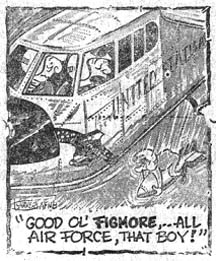 |
Page 12 TROPIC LIGHTNING NEWS December 16, 1966
5 Silver Stars Given Wolfhound Company
Sp4 Aaron Thomas of Philadelphia, Pa., distinguished himself when a comrade
near his position was wounded. Specialist Thomas, with complete disregard for
his own safety, advanced toward the wounded man until he became a casually
himself.
Realizing he could no longer move, he exposed himself to the enemy fire to
cover the medics who were treating the wounded until he died of injuries.
Sgt. Robert Taylor of Warsaw, Ind., was cited for his actions when his squad
was suddenly hit by enemy automatic weapons fire to their front. During the
initial attack, the squad took several casualties. Realizing his entire squad
was pinned down, Sgt. Taylor leaped to his feet and led an assault against the
enemy positions until he was killed. His quick actions and personal sacrifice
enabled the squad to reorganize and efficiently engage the enemy.
Five members of Co A, 2nd Bn, 27th Inf, “Wolfhounds” were posthumously
awarded the Silver Star for gallantry in action while the 25th Division and
elements of other American units were routing the 9th VC Division from their
longtime sanctuary in the dense jungles of War Zone C.
The five men lost their lives on November 5 when their company came under
intense enemy fire from concealed positions while on a search and destroy
mission near Dan Tieng, 60 miles northwest of Saigon.
PFC Roy Blewett, 23, of Dubuque, Iowa, was cited for moving to an open
position to lay down a heavy volume of fire into enemy positions while medics
evacuated the wounded. Private Blewett held the enemy down until he was killed
by an enemy bullet.
PFC Earl Hutton of Laharpe, Kan., heroically distinguished himself by
exposing himself to enemy fire when medics were attempting to extract wounded
personnel. Private Hutton did this to draw the hostile fire away from the
medics and towards himself. He did this steadfastly until he was fatally
wounded by a burst of enemy fire.
1st Lt. Alan Perrault of Needham, Mass., was cited for gallantry when his
platoon came under intense fire from its front. During the initial burst, Lt.
Perrault and several of his men were wounded. Refusing medical attention and
evacuation, he helped other wounded men and assaulted enemy positions. While
moving to the aid of another seriously wounded man, he was struck by hostile
fire a second time and was killed.
The heroism and personal sacrifices of all five men enabled other members of
the company to repel the enemy forces and displaying the valor and courage which
have been a Wolfhound trademark for nearly half a century.
| TOP TALK - Col. James G. Shanahan, commander of the 3rd Brigade Task Force and Col. Judson F. Miller, commander of the 2nd Bde, 4th Inf Div discuss strategy on Operation “Paul Revere IV.” |
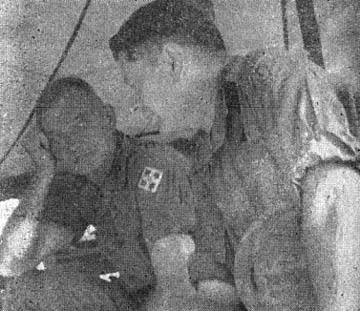 |
Medics Determine Type of Terrain By Analyzing Patients Treated
By PFC Doug Kearney
A medic can tell what kind of terrain his men have been working in just by
the kind of diseases they pick up. That’s the conclusion of PFC Angelo Soto,
22, of New York City, a medic with the 1st Bn, 27th Inf, “Wolfhounds.”
On Operation “Attleboro,” recently concluded by the 25th Division, the medics
either had more patients than they knew what to do with or else the cupboard was
bare. In one of those slack moments came the sudden realization that they wore
treating entirely new kinds of diseases.
PFC Soto recalled that most of the sick call problems in the past were skin
ulcers related to water or moisture. The Wolfhounds had spent most of their
time operating in rice paddy areas. Prolonged exposure to water often led to
severe cases of immersion foot or jungle rot.
But on Operation Attleboro the ground was considerably dryer and the problems
encountered at sick call proved it. One of the biggest problems that popped up
while he was in Zone C operations was the scourge of wood ticks.
According to PFC Soto, they were small, gray wood ticks and they were
extremely painful. The only way to get rid of them is to sponge the ticks with
alcohol and pick them out with tweezers. The wound is then treated with
tincture of methiolate.
What water there was in the woods was mostly slimly stagnant stuff - a real
favorite of the leeches. The 1/27th spent a night camped near such a an area
during the operation and sick call was bedlam the next morning. PFC Soto
recalled that every man seemed to have at least five or six of the sticky
bloodsuckers on his body that day.
PFC Soto and his fellow medics had finished treating the ten men or so that
they normally treat on sick call in the field, when they began to compare the
health of the VC to the health of their own men. They had an opportunity to
compare the two because they often have to treat wounded VC when on an
operation.
Many of the Viet Cong that came to the Wolfhound aid station were suffering
from some sort of foot disease.
Baby Born at 7th Surgical
The first baby has been born within the confines of the 25th Infantry
Division’s Cu Chi base camp. The birthplace was the 7th Surgical Hospital.
SSgt. Nathaniel Prince, the noncommissioned-officer-in-charge of the
division’s “Helping Hand Operations Center was enjoying a routine morning when
the stork arrived.
“Hey Sarge, there’s a woman over here having a baby,” called one of his men.
Sgt. Prince dashed across the grass, around a stack of tall boxes and sure
enough, there was one of the Vietnamese female workers ready to give birth.
A quick jeep ride got the woman safely to the Hospital where she had a baby
girl, two hours later.
The woman is now back at their village Ba-Ha 1 just outside the division’s
base camp. On the day she delivered the woman was unpacking and sorting donated
clothing.
The baby girl, named Lao, is being affectionately called Little Miss 25th by
the “Helping Hand” soldiers.
As Sgt. Prince noted, “We sure were surprised, but Helping Hand helps
everyone.
 |
Thanks to:
The 25th Infantry Division Museum for providing the volume of 1966 Tropic
Lightning News,
Ron Leonard, 25th Aviation Battalion for finding and mailing them,
Kirk Ramsey, 2nd Bn., 14th Inf. for creating this page.
This page last modified
01-21-2008
©2008 25th Infantry Division Association. All rights reserved